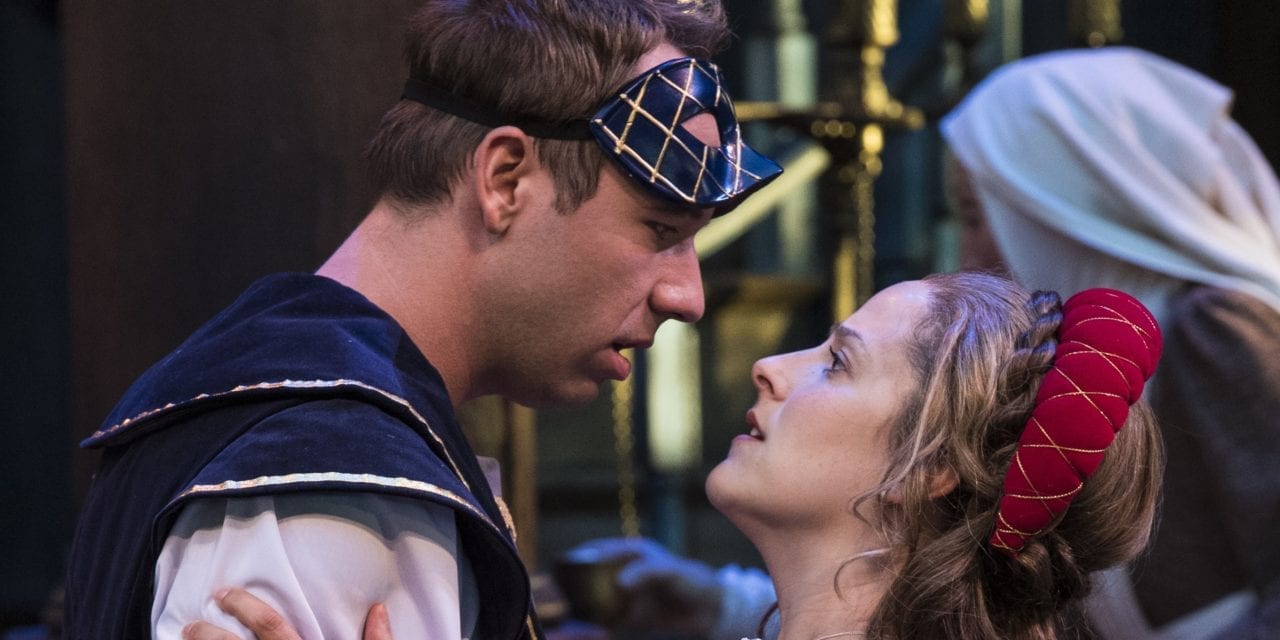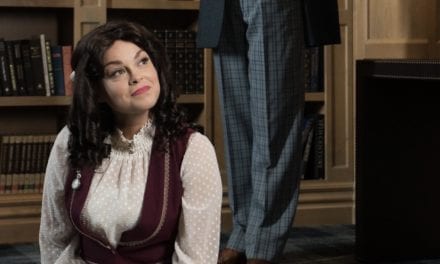In the space of seven months—from July 2017 to February 2018—I have seen four separate stage productions of Romeo and Juliet in Utah. Now it’s time for me to take a step back and evaluate what I learned from seeing four productions of Shakespeare‘s tale of “star-cross’d lovers.”
The Poetry Matters

Shane Kenyon as Romeo and Betsy Mugavero as Juliet in the Utah Shakespeare’s production of Romeo and Juliet. (Photo by Karl Hugh. Copyright Utah Shakespeare Festival 2017.)
Unless a rhyming couplet is unavoidable or the iambic pentameter is particularly strong, I don’t look for Shakespeare’s poetry when I watch a play. But the production at the Utah Shakespeare Festival last summer was particularly poetic, and I was surprised by how much I enjoyed it. The swinging lilt of the iambic pentameter in Juliet’s and Romeo’s lines as they fall in love with each other give the play a rhythm and flow that are almost hypnotic in some scenes. Although it is probably not easy for the actors, an emphasis on the poetry of Romeo and Juliet heightens the mood and makes it easy to see the characters as being special.
Another way the poetry matters in Romeo and Juliet that it allows for a contrast in the upper class and lower class characters. In many of his plays (including The Two Gentlemen of Verona and A Midsummer Night’s Dream), Shakespeare has his upper class characters speak in poetry and his poorer characters speak in prose. I don’t think Shakespeare was elitist when he made this decision. (One must remember the Bard’s own somewhat humble origins.) Rather, the choice feels more like a verbal shortcut for the audience to understand the social relationship among different character. In this case, the contrast is particularly noticeable in the difference between the nurse and Juliet. Hearing Juliet speak in poetry followed by the nurse’s prose is part of the humor of the nurse, and productions that don’t emphasize the poetry—such as Grassroots Shakespeare Company’s recent production—undercut some of the humor potential in the nurse.
Cutting Rosalind Helps Romeo

Maximillion Wright as Romeo in the BYU Young Company’s production of Romeo y Julieta. Photo by Savanna Richardson.
When the play opens, Romeo is feeling low after his love Rosalind has recently ended their relationship. Some productions open with a mopey, lovesick Romeo who whines for his former love. But this year I learned that the less Rosalind a production has, the better. BYU’s Romeo y Julieta for young audiences cut Rosalind completely from the script without any loss in character or plot. The result was a dynamic Romeo who didn’t wallow in his own emotional pain for the first act of the play.
A Play for All Ages—and for the Ages
Two of the four productions of Romeo and Juliet that I saw were directed at young audiences. The BYU production and the production at the Utah Children’s Theatre. The former lasted 60 minutes, while the latter clocked in at 45 minutes. Even in such brief running times, the essentials of the plot are easily communicated, and none of the message or tragedy of the story is lost when the play is stripped to its bones. The events of the play: swordfights, falling in love, taking one’s own life are so easily understandable that children can enjoy a brief production of Romeo and Juliet. In hindsight, this shouldn’t have been a lesson for me. After all, many schools use Romeo and Juliet as their students’ first introduction to Shakespeare. But it was still nice to see (multiple times) that the play works as well for children as it does for adults.
Additionally, the play is extremely well suited for changes in its setting. Two productions I saw (at the Utah Shakespeare Festival production and the Utah Children’s Theatre) kept the production set in Renaissance Italy, while the other two (Grassroots Shakespeare and BYU) gave contemporary touches to the play by mixing modern costume pieces with Renaissance garb. None of it mattered, and I think that the play is so universal in its themes that it can be set in almost any historical time period or location and still work well.
“Minor” Characters are Important

Lucas Adrian Buchanan as Romeo and Merry Magee as Juliet in Grassroots Shakespeare Company’s production of Romeo and Juliet. Photo by Ellen Nicole Allen.
But cutting more than half of the play (as three of the productions I saw did) still results in a loss. The full-length production at the Utah Shakespeare Festival made me realize the contributions of the parade of “minor” characters. When I saw later, slimmed-down, productions of the play, I found myself missing these characters.
Paris—the man that Juliet’s family wants to marry her to—experiences his own little tragedy. He is an innocent caught in the crossfire of the Capulet-Montague feud, and pays for it with his life. When I saw three productions in a row that had all cut him from the production, I found the depth of the tragedy blunted. Likewise, two of the productions cut Capulet and either Montague or Lady Montague. This didn’t hurt the integrity of the play as a whole, but having Juliet succumb to the will of her mother and father when they demand that she marry Paris, or having both of Romeo’s parents’ mourn his death is a powerful image.
The Play is Quite Masculine
Although Romeo and Juliet is—rightly—seen as a great romance, it is actually a quite masculine play. Swordfights, murders, the portrayal of young male camaraderie, and romantic conquest all make the play full of testosterone. Yes, there are domestic scenes at the Capulet home, but in the trimmed down productions I saw, these were cut for time, whereas the swordfights were not. Romeo and Juliet is far less likely to bore a typical man on a date than a “chick flick” would, plus a guy could easily score points with a girlfriend for being romantic enough to take his date to Romeo and Juliet.
What surprises me most about seeing Romeo and Juliet play four times in seven months is that I did not tire of it. Even after repeated viewings, the characters stay endearing and the ending can still move me. So, if you have already seen Romeo and Juliet and think you don’t need to see it again, well . . . I disagree with you. Give the show another shot and buy a ticket to the next production in your area.
Update: In 2021-2022, the author saw four productions of As You Like It in ten months. Afterwards, he wrote a similar list of lessons that he learned from seeing that play. You can read that discussion here.





